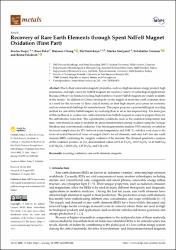| dc.contributor.author | Stopic, Srecko | |
| dc.contributor.author | Polat, Buse | |
| dc.contributor.author | Chung, Hanwen | |
| dc.contributor.author | Kaya, Elif Emil | |
| dc.contributor.author | Smiljanic, Slavko | |
| dc.contributor.author | Gürmen, Sebahattin | |
| dc.contributor.author | Friedrich, Bernd | |
| dc.date.accessioned | 2022-11-16T07:51:58Z | |
| dc.date.available | 2022-11-16T07:51:58Z | |
| dc.date.issued | 2022 | en_US |
| dc.identifier.citation | Stopic, S., Polat, B., Chung, H., Kaya, E. E., Smiljanić, S., Gürmen, S., & Friedrich, B. (2022). Recovery of Rare Earth Elements through Spent NdFeB Magnet Oxidation (First Part). Metals, 12(9), 1464. | en_US |
| dc.identifier.uri | https://hdl.handle.net/20.500.12846/693 | |
| dc.description.abstract | Due to their remarkable magnetic properties, such as a high maximum energy product, high remanence, and high coercivity, NdFeB magnets are used in a variety of technological applications. Because of their very limited recycling, high numbers of spent NdFeB magnets are widely available in the market. In addition to China's monopoly on the supply of most rare earth elements, there is a need for the recovery of these critical metals, as their high import price poses an economic and environmental challenge for manufacturers. This paper proposes a pyrometallurgical recycling method for end-of-life NdFeB magnets by oxidizing them in air as first required step. The main goal of this method is to oxidize rare earth elements from NdFeB magnets in order to prepare them for the carbothermic reduction. The experimental conditions, such as the oxidation temperature and time, were studied in order to establish the phase transformation during oxidation using the Factsage Database and experimental conditions. Our thermogravimetric analysis TGA analysis revealed an increased sample mass by 35% between room temperature and 1100 degrees C, which is very close to the total calculated theoretical value of oxygen (36.8% for all elements, and only 3.6% for rare earth elements REE), confirming the complete oxidation of the material. The obtained quantitative analysis of the oxidation product, in (%), demonstrated values of 53.41 Fe2O3, 10.37 Fe3O4; 16.45 NdFeO3; 0.45 Nd2O3, 1.28 Dy2O3, 1.07 Pr2O3, and 5.22 alpha-Fe. | en_US |
| dc.language.iso | eng | en_US |
| dc.publisher | MDPI-Multidisciplinary Digital Publishing Institute | en_US |
| dc.relation.isversionof | 10.3390/met12091464 | en_US |
| dc.rights | info:eu-repo/semantics/openAccess | en_US |
| dc.subject | Recycling | en_US |
| dc.subject | Oxidation | en_US |
| dc.subject | Rare Earth Elements | en_US |
| dc.subject | Magnets | en_US |
| dc.subject | Geri Dönüşüm | en_US |
| dc.subject | Nadir Toprak Elementleri | en_US |
| dc.subject | Mıknatıslar | en_US |
| dc.subject | Elemente der Seltenen Erden | en_US |
| dc.title | Recovery of rare earth elements through spent NdFeB magnet oxidation (first part) | en_US |
| dc.type | article | en_US |
| dc.relation.journal | Metals | en_US |
| dc.contributor.authorID | 0000-0002-9945-1199 | en_US |
| dc.identifier.volume | 12 | en_US |
| dc.identifier.issue | 9 | en_US |
| dc.relation.publicationcategory | Makale - Uluslararası Hakemli Dergi - Kurum Öğretim Elemanı | en_US |
| dc.contributor.department | TAÜ, Fen Fakültesi, Malzeme Bilimi ve Teknolojileri Bölümü | en_US |
| dc.contributor.institutionauthor | Kaya, Elif Emil | |
| dc.identifier.wosquality | Q2 | en_US |
| dc.identifier.scopusquality | N/A | en_US |
| dc.identifier.wos | WOS:000856909800001 | en_US |

















